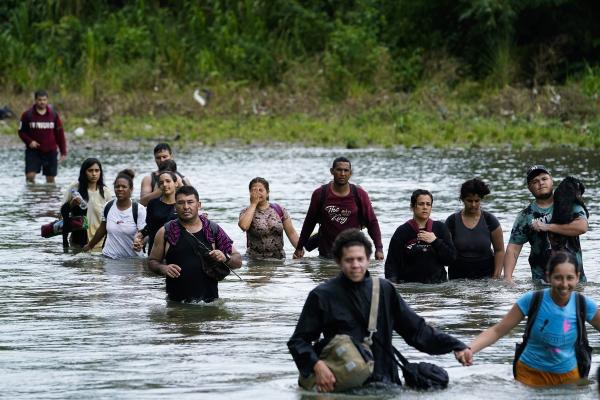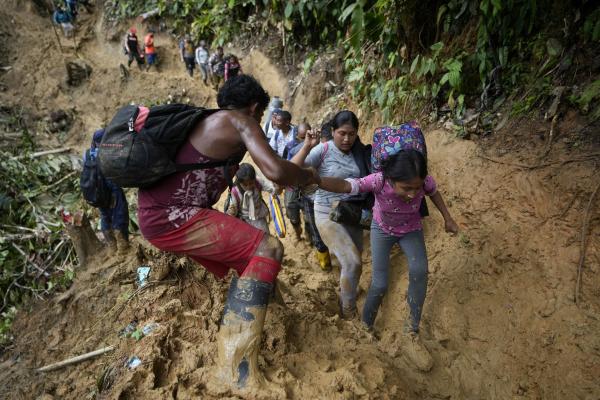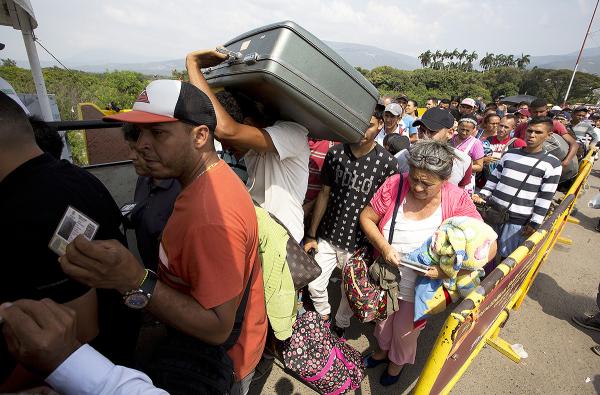How many migrants have come to Chicago in the last few years?
Since August 2022, more than 47,000 migrants have been sent to Chicago from Texas. About 40,000 of them were sent on buses, and 30 percent of them are children, many babies and toddlers.
Where are they from?
The great majority are from Venezuela, but there are also people from Ecuador, Haiti, Colombia, and Peru, as well as other countries in Africa, Europe, and the Middle East.
What was their journey like to get to the U.S.?

Migrants, mostly from Venezuela, cross the Tuquesa river after trekking through the Darien Gap, October 4, 2023. Photo: AP
Most of the immigrants from Venezuela traveled thousands of miles over many months, much of it walking, to get to the U.S. border. They were so desperate that they were willing to cross a dangerous jungle on the border of Panama and Colombia called the Darién Gap on foot, carrying their children and possessions. There are no roads or towns for 60 miles in the Darién Gap… some children were swept away in rivers while families were trying to cross them… they ate at most one meal a day during their journey. After that, they still had to cross through several more countries to get to the U.S.-Mexico border.
Are these people "illegal" immigrants?
No. They are legal asylum seekers who came to the U.S. because their lives were in danger in their home country. Asylum seekers are following what U.S. law requires—people must physically come to the U.S. and present themselves to an official to declare their request for asylum. They must apply for asylum within one year, and applying gives them legal protection and the right to remain in the U.S. while they wait for a court decision on their request for permanent asylum.
How did they end up in Chicago?

Venezuelan migrants walk across the treacherous Darién Gap from Colombia into Panama hoping to reach the U.S., October 15, 2022. Photo: AP
The fascist anti-immigrant governor of Texas has chartered 946 buses (as of September 4, 2024) to move the migrants out of Texas and into Chicago (and he has bused thousands more immigrants to other northern cities). Once in Chicago, they were dumped at all times of the day and night like they were unwanted garbage. Most of the migrants knew nothing about Chicago, did not choose to come here, did not know anyone here, and had never experienced winter—they were often wearing only T-shirts and flipflops when they were dropped off in frigid weather. The 1,000-mile plus trip was often without food, water, baby and medical supplies, or rest stops.
What was life like when the migrants first arrived in Chicago?
Most had little or no money, no food, no clothing, no sponsors or places to stay, and did not speak English. For many months, thousands of migrants, including babies and children, slept on the hard floors of police stations or the airport or outside on the sidewalks in tents with no showers and few bathrooms. All the bedding, meals, diapers, medical care and other means to live were provided by volunteers from mutual aid teams, religious institutions, and charities, not by the government.
What assistance are the migrants getting from the government?
As the number of buses carrying the asylum seekers from Texas grew by the day, some city, state and federal resources were allocated for the city to set up contracts for meals and temporary shelters in park districts, closed schools, warehouses and hotels. This was on the most basic emergency survival-level humanitarian basis. They now are being evicted from the shelters after 60 days. Initially, the migrants were allowed to work legally only after going through a months-long process of applying for limited work permits. Lawyers volunteered to help them fill out the forms, as there was no government help. Doctors and volunteer medical teams provide basic medical care, local public health only offered vaccinations.
Asylum seekers generally do not qualify for federal benefits programs like food stamps, Section 8 housing, and Medicaid until they have been legally approved for asylum status and then only under limited conditions. Since it takes over a year to be approved for asylum status, the vast majority of new migrants do not receive these benefits. In order to shut down some of the city-run shelters and save money spent on sheltering and feeding migrants, some state and local funds were allocated to get migrants into private apartments by paying landlords for just three months’ rent. They must apply again to receive another three months of aid, for a total of up to $15,000. After that the migrants are on their own, even if they have no permit to work legally. Public school systems are required to enroll students regardless of their immigration status, and over 9,000 migrant children are enrolled in Chicago as of September 2024.
Venezuelans who have been in the U.S. continuously since September 2023 qualify for federal Temporary Protected Status (TPS). TPS holders are generally eligible to access government social services such as Medicaid, Supplemental Nutrition Assistance Program, and housing assistance, such as federal public housing or Section 8 rental assistance.
Are migrants getting $5,000 Visa cards from the government?
No. This was a false rumor spread by a Republi-fascist politician in Arizona and reactionary social media around the country. This claim has no basis in fact and has been widely debunked.
Why are so many Venezuelans leaving their country?

As Venezuela's economic crisis worsens, rising numbers are fleeing in a burgeoning refugee crisis. More than seven million Venezuelans have migrated in the past seven years. Here, refugees wait to cross the border into Colombia. Photo: AP
The situation for the masses of people in Venezuela is unbearable. Estimates are that half of the population is in poverty, 6.5 million Venezuelans suffer from hunger and at least 7.7 million people (a quarter of the population) have already left Venezuela to search desperately for a way to survive.
Who is responsible for this horrific situation in Venezuela?
This is a crisis made in the USA. Since 2002 the U.S. has attempted repeated coups targeting the Venezuelan regimes of Hugo Chávez and Nicolás Maduro, which have clashed with the U.S. in some limited ways. Under Obama and then Trump, the U.S. issued an escalating series of economic sanctions that have played a major role in devastating the economy. As a result, millions of people in Venezuela are unable to meet life’s most basic needs like water, food, fuel, shelter, and health care.